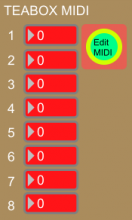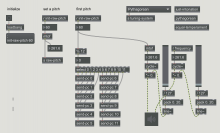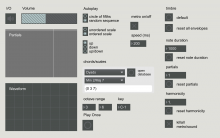- Search:
-
- Quicklinks:
HAL Downloads
For license details, please visit the HAL Contact page.
Electrotap Teabox Midi interface

This is a custom Max abstraction for the Electrotap Teabox sensor interface.
The major goals for this code are:
1) Create a modular GUI for the Teabox that can be inserted into other Max environments.
2) Create a general MIDI output structure to parse and send messages from the Teabox.
Please see the HAL_Teabox.rtf for more info.
3D Particle Rendering and Audification with Jit.gen

Starting with a exploration in real time animation, this patch was built as a proof of concept mapping particle systems onto geometry and then manipulating that geometry. This example uses a 3D field of noise wrapped onto the surface of a torus that is then rendered with a git.gl.mesh. The primitives used in the patch can be rendered as triangles, lines, or points resulting in a different image and sound. The 3D model can also be rotated.
HAL Tuning Package

There are two main tuning system families: logarithmic and ratio based tuning systems. If you are interested in ratio based tuning, please look at my other patch. The purpose of this patch is to demonstrated different tuning possibilities within equal temperament. The chromatic 12 note scale is ubiquitous and is generated through a series of operations involving the 12th root of 2. But the same algorithm can also be used to create 17 equal tempered notes within an octave, or 47. In addition, one can generate the Pierce-Bohlen scale by using the same algorithm except for substituting the mathematical operation with the 13th root of 3. There are many possibilities!
There are more tuning system than just equal-temperament or TET, on which most MIDI systems are based. This particular patch shows the Pythagorean Method and Just Intonation to get started, but it would be easy to create any type ratio tuning system from ancient music theory treatise to the ones created by Harry Partch.
Created and Tested by Reiner Krämer.
Additive Synthesis Package

The purpose of this patch was to pull together several Max programming techniques into one patch. At its core, the patch creates a “tone” through additive synthesis. However, the partials are generated on the fly using JavaScript. The partials are generated to the natural harmonic series, and can be detuned” through the harmonicity function. For example, the harmonic series can be tuned to the golden ratio (1.618) globally. Another JavaScript generates are corresponding envelope for each partial. When presentation mode is turned off, each individual partial that was previously dynamically generated can be find-tuned to create all kinds of additional timbres.
Created and Tested by Reiner Krämer.
Max Interface for Akai LPD8 Controller

This is HAL's custom Max interface for the Akai LPD8 USB controller. The code integrates the original LPD8 editor into a regular user-made Max environment and creates GUI feedback for the LPD8's programming that can be inserted into another Max GUI.
Max Interface for Keith McMillen Softstep Controller

This is HAL's custom Max interface for the Keith McMillen USB controller. It is a modular GUI for the Softstep that can be inserted into other Max environments and creates a general MIDI output structure to parse and send messages from the Softstep.